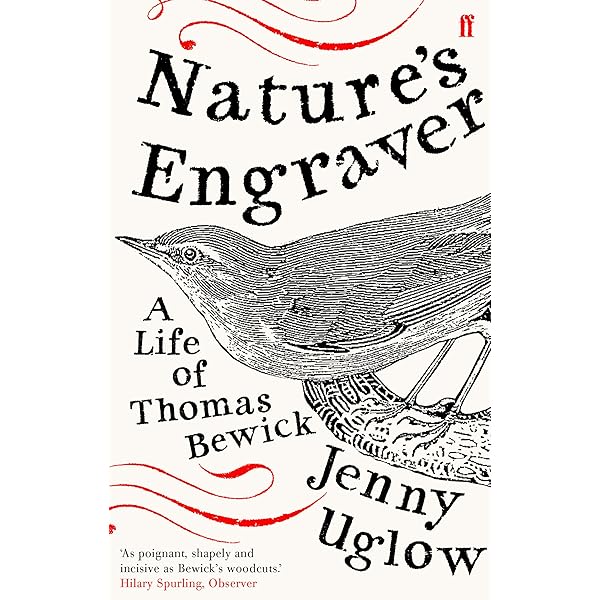It was with delight that the Dr Johnson Reading Circle met again in person for the first time in sixteen months. While the more regular online meetings had been something of a lifeline for members, they were not the same as being together and in Dr Johnson’s House. Much had changed, people had moved to further flung corners of the country but there was still enough people to form a decent group and there were even a new visitor, who had a family connection with one of Thomas Bewick’s works.
We were there to discuss Nature’s Engraver: A life of Thomas Bewick by Jenny Uglow. We had greatly enjoyed Lunar Men together and anyone who picks up one of her biographies would agree that she has a talent for telling a life in a way that is both authoritative and enjoyable to read.
Bewick engraved on wood, often for publications and his work has probably seeped into British consciousness. It was only the American member in the room who had never come across him before, everyone else having grown up with him, either in the Opie’s collection of nursery rhymes, as end-pieces in country cookbooks or with his own Book of English Birds. Since creating his images, they’ve become a part of childhood in the UK, popping up in Jane Eyre, as she hides behind the curtain to look at the pictures or with Virginia Woolf, sitting on her father’s lap. What kind of life led to the creation of these images?
Uglow starts the book in the countryside outside of Newcastle, in a small village called Cherryburn where the oldest son of a farmer (and coal-mining sub-contractor) is running wild. He bunks off school, scribbles pictures in the back of a pew and takes his friends on a voyage down an almost freezing river on an iceberg. Spanking doesn’t correct him, nor does being locked in the church bell tower - he proceeds to ring the bells as loud as he can. The boy needs an outlet for his energy.
He finds this in Newcastle, the nearest large city, which is growing rapidly at this time. It’s a place subject to massive storms, one of which swept its only bridge away, complete with the houses on it. There, Bewick became the apprentice of an engraver. He’d always enjoyed drawing and found himself very skilled at the task. At first he was given the easy jobs but he began to work on more difficult ones. He heard of a new way of achieving woodcuts far more textured and detailed than the ones that had been in chap books and cheap broadsides, using the dense end of boxwood to create subtler pictures. It’s interesting that someone with so much energy could concentrate for hours at a time carving out careful lines. Both his scattershot energy and his ability to focus minutely would aid him to become the best at what he did.
He seems to have been a tremendously physical person, walking seventeen miles home in all weather every weekend to see his family and taking even longer walks to distant parts of the country. The countryside made him happy and although he grew to hate bloodsports, he would go out fishing for days at a time. These walks inspired many of his characteristic little engravings, all of them full of detail and movement, often telling stories. There’s one of a horse with evil intent in its eye as a baby comes to pat it. The mother is running to the baby as the nursemaid is meeting company in a bush beyond. There’s another of a farmer carrying a cow across a river to save the toll on the perfectly good bridge behind him. These are small works full of energy but engraved with care and the book gains massively from their inclusion throughout.
In some ways, the book could be read as an example of the story of the ‘good apprentice’. A formally unruly child knuckles down to hard work, produces things he can be proud of and builds up a business and family that allow him to be respected in his community and beyond. Unlike Hogarth, he doesn’t yearn to be more than an engraver, he wishes to be the best engraver he can. There are tragedies in his life, he is greatly affected by the deaths of his parents and his younger brother, but his is a life relatively unruffled. He had a quick temper and often fell out with business associates but was also quick to make up, and these associations continued long after they were useful. He was politically radical, attending discussion and debate groups, but not so outspoken he was ever picked up by the increasingly paranoid authorities. He loved animals and hated cruelty to them, but would frequently depict fox-hunting scenes because he knew they would sell with the wealthy horse and dog set. Like his work, his life was a balance between his energy and his steady focus.
As a result, this biography is a pleasant, gentle, measured book. The story of a man who diligently made beautiful things. There isn’t the tragedy of Mrs Jordan’s Profession, nor the hubbub of Casanova: Actor, Lover, Priest, Spy. It’s a book to read on a calm, summer’s day - or when longing for one, and it was a smooth, unruffled return to meeting in person.



No comments:
Post a Comment